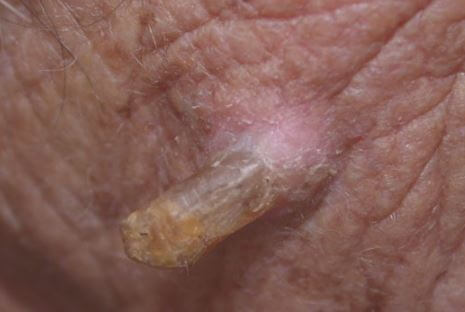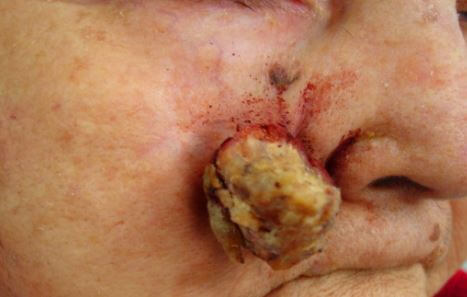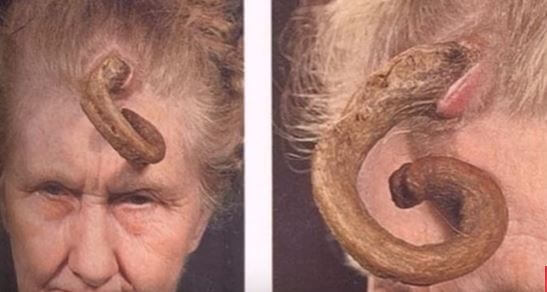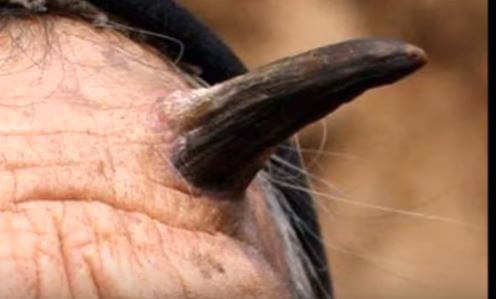What is Cutaneous Horn?
A cutaneous horn is a tumor on the skin surface that resembles a miniature horn. Cutaneous horns are usually keratin tumors on the skin, which appear as horns although sometimes they may look and feel like wood or coral. They are usually small and cone shaped, not much larger than a few millimeters although they can grow to several centimeters.

Pain and Irritation
Cutaneous horns are often painless unless bumped or struck, which can lead to pain or inflammation and at times bleeding at the base of the horn. They can also be painful if they occur in areas prone to physical irritation. In the event that a person feels pain, it may be an indicator that the cutaneous horn is caused by cancerous cells.
How do Cutaneous Horn form?
The human skin at its outer layer is made up of a strong protein known as keratin, it is this that protects the inner cells of the skin. Keratin is found in the hair, the skin and the nails. It is also this protein that forms the horns in animals. When keratin is compacted in the skin, it leads to formation of cutaneous horns.
Cutaneous horns resemble miniature horns and they are formed from keratin.
Causes
Although the root cause of cutaneous horns still remains unknown, a number of factors are believed to trigger the condition. These factors include: cancer, old age which leads to aging of the skin(seborrheic keratosis), or exposure to solar and ultraviolet radiation. Another thing associated with cutaneous horns is contraction of the Human Papilloma Virus (HPV), which causes warts on the skin, especially the HPV-2 subtype has been suggested.
Who are Commonly Affected?
The people commonly affected by cutaneous horns are adults, mostly the elderly between the ages of sixty to seventy and with a history of significant exposure to the sun. It occurs commonly amongst individuals with lighter, fairer skin.
In majority of people having cutaneous horns, they usually appear in areas that are often exposed to sunlight. Although this condition affects both male and female equally, the rate of the tumor being cancerous in nature is higher in men than women.
Signs
Some of the signs of having cutaneous horns are:
- Growth of a cone-shaped or funnel-shaped protuberance on the skin that is usually brown or yellow in color and firm to the touch
- This cone-shaped or funnel-shaped protuberance mostly occurs in areas of the body that tend to be exposed to the sun like the hands, forearms, head, and ears, but they may also occur in parts of the body that are protected from the sun like the chest, neck, shoulders, and the penis.
- Cutaneous horns mainly occur singularly, but they can also be multiple in some cases
- For a typical horn, its height may be twice the size of the base
- Cutaneous horns can grow to enormous, giant sizes – the largest horn to be described was in the 19th century that formed on a woman whose name was Madame Demanche in Paris France.
Are Cutaneous Horns Dangerous?
Cutaneous horns can either be benign meaning non cancerous (ranging from mild effects to harmless) or malign, which is commonly attributed to squamous cell carcinoma (one of the major types of skin cancer, which at its early stage can be cured, but if left unchecked can be fatal).
Skin cancer at its later stages is difficult to cure and may at times spread its cancerous infection to other parts of the body. However, about forty percent of the cases involving cutaneous horns are of cancerous origin with the other sixty percent attributed to benign or mild causes, which are easily treatable.
Symptoms
Symptoms that a cutaneous horn may be cancerous include the following:
- Inflammation or pain or redness at the base of the horn
- A short cutaneous horn with a large base
- Horn located at on the penis- this may be an indicator of skin cancer (squamous cell carcinoma)
- Hard and thickened skin at the base of the horn
- Tenderness at the base of the cutaneous horn
- A large sized horn
- Lack of terraces on the side of the horn, which is usually an indicator of rapid formation of the horn due to cancer

Redness at the base of the cutaneous horn as well as swelling may be an indicator of cancer (squamous cell carcinoma).
How can you Treat Cutaneous Horns?
It is important to note that treatment cannot continue until a biopsy has been conducted to determine the condition of the cells causing the cutaneous horn.
If the cutaneous horn is likely to develop into cancer, a doctor my consider the following treatment options:
- Using liquid nitrogen to freeze the tumor
- Using anti-cancer drugs such as 5-Fluorouracil or a medicine that is applied onto the skin such as lotion or ointment in order to stimulate the body’s immune system into destroying any cancerous cells
- Through curettage and electrodessication of the tumor.
If the cutaneous horn is cancerous in nature (has a higher likelihood of developing into cancer) more adverse treatment options need to be considered, for example:
- Treatment through surgery
- Using anti-cancer drugs such as 5-Fluorouracil or a medicine that is applied to the skin as lotion or ointment in order to stimulate the body’s immune system into destroying any cancerous cells.
- Through curettage and electrodessication of the tumor.
- Radiation therapy is also recommended, and it follows after the surgical removal of the cutaneous horn) to destroy cancerous cells.
- Chemotherapy is also used to reduce or destroy the cancerous cells (usually follows after the surgical removal of the cutaneous horn).
Cutaneous horns are not painful unless they have been bruised, or if the horn is of cancerous origin, which is usually a low occurrence. Although the majority of cases involving cutaneous horns are benign or premalignant, early treatment may help alleviate any risk of cancer.
Cutaneous Horn Removal
When a physician or dermatologist finds that you have a pre-cancerous or cancerous cutaneous horn, they will suggest that it be removed. A specialist is required to remove it – the person removing the cutanoeous horn needs to be a medical professional qualified to safely remove them or he or she should be a dermatologist. The way they are removed is going to depend on the category they fall into.
For Pre-Cancerous Removal
If the cutaneous horn is pre-cancerous, it can be frozen using liquid nitrogen. With cryosurgery the surgeon removes the horn by using extreme cold. In the procedure, a local anesthetic is given before applying liquid nitrogen that is sprayed to the horn or swabbed. The extreme cold will damage the tissue that makes up the horn making the horn to fall off. Doctors will use cryosurgery if the horns are caused by specific conditions such as verruca vulgaris, keratosis, and molluscum contagiosum.1,2,3
A doctor may scrape and burn the cutaneous horn a process known as curettage and electrodesiccation.
A doctor may use topical medication to stimulate the immune system, a topical chemotherapy agent may also be used which is an anti-cancer medication to help with the removal of the cutaneous horn thereafter. A lingering redness may occur when a topical cream is used, however, it will fade away with time.
For Cancerous Removal
If the cutaneous horn is cancerous, different removal procedures may be applied. A doctor may perform surgery to remove it. The horn along with the surrounding tissue are removed to prevent spreading of malignant cells. The doctor will also take the extracted tissue for further examination to help determine the severity of the horn. Radiation therapy will be used to destroy any cancerous cells that may be remaining.
The doctor may also use the curettage and electrodesiccation procedure to extract the horn. An anti-cancer medication in form of a topical chemotherapy agent can help gradually remove the cutaneous horn. The doctor may also use a topical medication that stimulates the patient’s immune system to help with extraction of the horn.1,3
Pictures




Reference list:
- http://www.healthcentral.com/skin-cancer/c/1443/162612/cutaneous-horn/
- https://www.skinsight.com/skin-conditions/adult/cutaneous-horn
- http://www.dermnetnz.org/topics/cutaneous-horn/
- http://www.emediscine.medscspe.com/article/1056568-overview
- http://www.pcds.org.uk/clinical-guidance/cutaneous-horn
- https://www.ncbi.nlm.nih.gov/pmc/articles/PMC421749/
- http://healthool.com/cutaneous-horn/
- Cutaneous Horn – https://perridermatology.com/actinic-keratosis/actinic-keratosis-cutaneous-horn/
- Cutaneous Horn. https://healthool.com/cutaneous-horn/
- What is a cutaneous horn? https://www.medicalnewstoday.com/articles/318953.php
- Cutaneous Horn. https://heydoctor.org/cutaneous-horn.html
